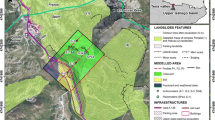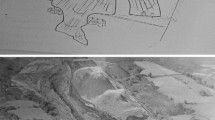Abstract
This paper proposes a hydro-geomechanical finite element model to reproduce the kinematic behaviour of large slow landslides. The interaction between solid skeleton and pore fluids is modelled with a time dependent u–p w formulation and a groundwater model that takes into account recorded daily rainfall intensity. A viscoplastic constitutive model based on Perzyna’s theory is applied to reproduce soil viscous behaviour and the delayed creep deformation. The proposed model is applied to Portalet landslide (Central Spanish Pyrenees). This is an active paleo-landslide that has been reactivated by the construction of a parking area at the toe of the slope. The stability analysis reveals that, after the constructive solutions were undertaken, the slope is in a limit equilibrium situation. Nevertheless, time-dependent analysis reproduces the nearly constant strain rate (secondary creep) and the acceleration/deceleration of the moving mass due to hydrological changes. Overall, the model reproduces a 2-m displacement in the past 8 years that coincides with in situ monitoring data. The proposed model is useful for short- and mid-term predictions of secondary creep. However, long-time predictions remain uncertain, stability depends strongly on the position of the water table depth and new failures during tertiary creep due to soil temporal microstructural degradation are difficult to calibrate.
















Similar content being viewed by others
References
Abbo AJ, Sloan SW (1995) A smooth hyperbolic approximation to the Mohr–Coulomb yield criterion. Comput Struct 54(3):427–441
Álvarez-Fernández MI, González-Nicieza C (2011) Ensayos de hincamiento con cilindro hidráulico. Technical Report for Instituto Geológico y Minero de España. Control Remoto Sudoe Doris Project (in Spanish)
ARCO TECNOS SA (2010) Sondeos en alrededores de la estación de Formigal (Huesca). Technical Report for Instituto Geológico y Minero de España. Control Remoto SudoedorisProject (in Spanish)
Bixel F, Muller J, Roger P (1985) Carte géologique du Pic du Midi d’Ossau et haut bassin du río Gállego, 1:25.000. Institut de Géodynamique, Université de Bordeaux, Bordeaux
Cruden DM, Varnes DJ (1996) Landslide types and processes. In: Turner AK, Shuster RL (eds) Landslides: investigation and mitigation. Transportation Research Board, National Research Council, Special Report 247. National Academy Press, Washington, pp 36–75
Dawson EM, Roth WH, Drescher A (1999) Slope stability analysis by strength reduction. Geotechnique 49(6):835–840
De Souza Neto EA, Peric D, Owen DRJ (2008) Computational methods for plasticity: theory and applications. Wiley, Chichester
Desai CS, Samtani NC, Vulliet L (1995) Constitutive modeling and analysis of creeping slopes. J Geotech Eng, ASCE 121(1):43–56
Dounias GT, Potts DM, Vaughan PR (1988) Finite element analysis of progressive failure: two case studies. Comput Geotech 6:155–175
Federico A, Popescu M, Fidelibus C and Interno G (2004) On the prediction of the time of occurrence of a slope failure: a review. In: Proceedings 9th International Symposium on Landslides, Rio de Janeiro, Taylor and Francis, London, vol. 2, pp 979–983
Fell R, Hungr O, Leroueil S and Riemer W (2000) Keynote Lecture-Geotechnical engineering of the stability of natural slopes, and cuts and fills in soil, GeoEng 2000, Vol.1, Invited Papers, Technomic Publishing, Lancaster, pp.21–120
Fernández-Merodo JA, Herrera G, Mira P, Mulas J, Pastor M, Noferini L, Mecatti D andLuzi G(2008) Modelling the Portalet landslide mobility (Formigal, Spain). iEMSs 2008: International Congress on Environmental Modelling and Software. Sànchez-Marrè M, Béjar J, Comas J, Rizzoli A and Guariso G (eds) International Environmental Modelling and Software Society (iEMSs)
Fernandez-Merodo JA (2001) Une approche à la modélisation des glissements et des effondrements de terrains: Initiation et propagation. Thèse de l’École Centrale Paris, no 2001–33 (in French)
François B, Tacher L, Bonnard C, Laloui L, Triguero V (2007) Numerical modelling of the hydrogeological and geomechanical behaviour of a large slope movement: the Triesenberg landslide (Liechtenstein). Can Geotech J 44:840–857
García Ruiz JM, Chueca J, Julián A (2004) Los movimientos en masa del Alto Gállego. In: Peña JL Longares L.A, Sánchez M (eds) Geografía Física de Aragón. Aspectos Generales y Temáticos, pp. 142–152.
Herrera G, Fernández-Merodo JA, Mulas J, Pastor M, Luzi G, Monserrat O (2009) A landslide forecasting model using ground based SAR data: The Portalet case study. Eng Geol 105:220–230
Herrera G, Notti D, García-Davalillo JC, Mora O, Cooksley G, Sánchez M, Arnaud A, Crosetto M (2011) Analysis with C-and X-band satellite SAR data of the Portalet landslide area. Landslides 8:195–206
Leroueil S, Locat J, Vaunat J, Picarelli L and Faure R (1996) Geotechnical characterization of slopemovements. In: Senneset K (ed) Proceedings of the Seventh International Symposium on Landslides, Trondheim, Norway, Balkema, Rotterdam, vol 1, pp.53–74
Mira P (2001) Análisis por elementos finitos de problemas de rotura de geomateriales. Tesis Doctoral de la ETS de Ingenieros de Caminos, Canales y Puertos. Universidad Politécnica de Madrid (in Spanish)
Ortiz M, Popov EP (1985) Accuracy and stability of integration algorithms for elastoplastic constitutive relations. Int J Numer Methods Eng 9:1561–1576
Oviedo University (2011) Método y sistema para la realización de ensayos in situ y caracterización de terrenos heterogéneos o macizos rocosos intensamente fracturados. Spanish patent no ES-2351498-A1 (in Spanish). http://www.oepm.es/pdf/ES/0000/000/02/35/14/ES-2351498_A1.pdf. Accessed 27 Sept 2012
Owen DRJ, Hinton E (1986) Finite elements in plasticity. Pineridge, Swansea
Perzyna P (1966) Fundamental problems in viscoplasticity. Rec Adv Appl Mech 9:243–377
Simo JC, Taylor RL (1985) Consistent tangent operators for rate independent elastoplasticity. Comput Methods Appl Mech Eng 48:101–118
Tacher L, Bonnard C, Laloui L, Parriaux A (2005) Modelling the behaviour of a large landslide with respect to hydrogeological and geomechanical parameter heterogeneity. Landslides 2(1):3–14
Troncone A (2005) Numerical analysis of a landslide in soils with strain-softening behaviour. Geotechnique 55(8):585–596
Van Asch TWJ, Van Beek LPH, Bogaard TA (2007) Problems in predicting the mobility of slow-moving landslides. Eng Geol 91:46–55
Varnes DJ (1978) Slope movement types and processes. In: Landslides, analysis and control. National Academy of Sciences, Nat. Res. Cou, Washington, Special Rep. vol 176, pp.11–33
Vulliet L (2000) Natural slopes in slow movement. In: Zaman M, Booker JR, Gioda G (eds) Modelling in geomechanics. Wiley, Chichester, pp 654–676
Wang WM, Sluys LJ, de Borst R (1997) Viscoplasticity for instabilities due to strain softening and strain-rate softening. Int J Num Meth Eng 40:3839–3864
Zienkiewicz OC, Shiomi T (1984) Dynamic behaviour of saturated porous media: the generalised biot formulation and its numerical solution. Int J Num Anal Meth Geomech 8:71–96
Zienkiewicz OC, Chan AHC, Pastor M, Shrefler BA, Shiomi T (1999) Computational geomechanics with special reference to earthquake engineering. Wiley, Chichester
Zienkiewicz OC, Taylor R (2000) The finite element method, 5th edn. Butterworth-Heinemann, Oxford
Acknowledgements
This work has been partially funded by the Terrafirma Global Monitoring for Environment and Security program from ESA, the project DO-SMS (SUDOE INTERREG IV B), the DORIS Project “Ground Deformation Risks Scenarios: an Advanced Assessment Service” (EU-FP7-SPACE-2009-1n 242212) and the Project SAFELAND “Living with landslide risk in Europe: Assessment, effects of global change and risk management strategies” (EU-FP7-ENV-2008-1 n 226479).
Author information
Authors and Affiliations
Corresponding author
Rights and permissions
About this article
Cite this article
Fernández-Merodo, J.A., García-Davalillo, J.C., Herrera, G. et al. 2D viscoplastic finite element modelling of slow landslides: the Portalet case study (Spain). Landslides 11, 29–42 (2014). https://doi.org/10.1007/s10346-012-0370-4
Received:
Accepted:
Published:
Issue Date:
DOI: https://doi.org/10.1007/s10346-012-0370-4




